
Adventures in an Urban Kitchen Garden
HERBS 2025
|
|||||||||||||
| Basil (Start seedlings on February 16) Start seeds 1/4" deep. Ideal germination temperature is 70-85 F. Basil seeds germinate best when soil temperatures are 75-85°F and take about 10-14 days to sprout. Transplants take 4-6 weeks to grow to size. Basil does not like cool weather and will suffer if you force it. Basil requires some additional nitrogen to sustain rapid leaf growth. When pinching plants back to produce more leaves or growing in pots, fertilize regularly with an all-purpose soluble fertilizer. Once the plants reach the harvestable stage, sidedress with organic or all-purpose liquid nitrogen sources by applying 1-2 T of fertilizer every 2-3 weeks per 10 foot of row. Fertilizer pots weekly. Grow in full sun. Thrives in heat. When the plants have 6 to 8 leaves, harvesting can begin; remove enough of the stem so that only 2 to 4 leaves remain. Basil excels at repelling troublesome insects like aphids, asparagus beetles, flies, and tomato horn worms.
|
|||||||||||||
 |
a) Genevese Classic Italian variety. 68 days Authentic flavor and appearance. Tall and relatively slow to bolt with large, dark green leaves about 3" long. This common strain of Genovese basil can present some variability in leaf shape and plant size. While quite suitable for field and garden, we recommend using a more modern and more uniform variety for greenhouse, container, or hydroponic production, such as Genovese Compact Improved, Aroma 2, Nufar, Dolly, or the Prospera® series. Ht. 24–30". Edible Flowers: Use the flowers in any recipe that calls for basil, or to garnish drinks, salads, soups, pasta, and desserts. Flavor is of intense basil. |
|
|||||||||||
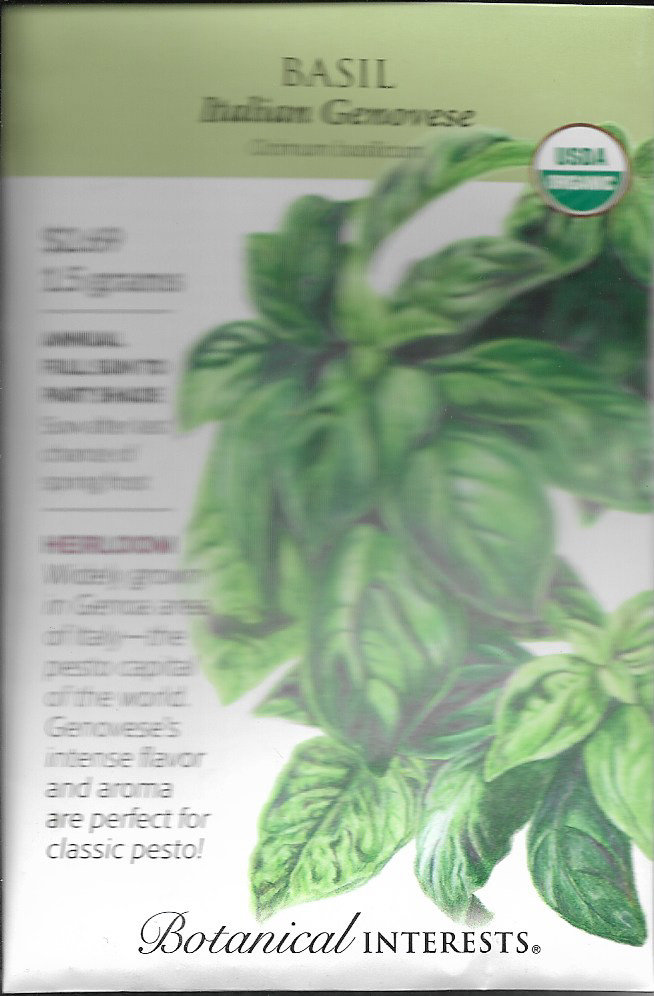 |
b) Italian Genovese There is nothing like the aroma of basil in the summer! Genovese has the traditional fragrance and flavor, making it excellent for almost any basil dish, especially pesto. One of the most useful herbs, it also has beautiful, edible flowers. In a warm, sunny window, basil can grow indoors in the winter! A good container variety. Family: Laminaceae Hardiness: Frost-sensitive annual Exposure: Full sun to part shade Plant Dimensions: 18"–24" tall, 10" wide Variety Info: Large, dark green almond-shaped leaves. This is the true Italian pesto basil from the Genoa area of Italy, pesto capital of the world. Attributes: Good for Containers |
|
|||||||||||
| Catnip The herb that drives cats wild is also medicinal; used in a tasty herbal tea for colds and flu. Vigorous plant. 6-12 hours of Sun Sprouts in 7-14 Days Ideal Temperature: 70-75 F Seed Depth: Surface Sow Plant Spacing: 12-18" |
|||||||||||||
| Chives (Started seedlings on January 28 - failed) Seeds should be planted ¼ inch deep. They germinate in 7-14 days. Keep seeds consistently moist until germination. Ideal germination temperature of 55-60 F. Transplants need 6-8 weeks of growth before planting in the garden. Transplants or divisions can be planted in late April or early May. Final plant spacing should be 4-6 inches apart in all directions. Dividing existing plants into smaller units easily propagates chives. Chive beds should be split up every 2-3 years. Harvest chives by cutting the leaves back to within 1-2 inches of the soil. Use chives fresh or dry them for storage. Will tolerate part to even heavy shade. Chives like to be consistently well watered. Perennial chives that get divided are much more productive. Sidedress in May and July with 1 teaspoon of 21-0-0 fertilizer per square foot to ensure good growth and high yields. A typically pest-free plant, chives are interplanted in the garden to help ward off certain insect pests.  |
|||||||||||||
 |
a) Common Wonderful, mild onion flavor. These long, thin chives are excellent in many meals; great raw or cooked. Lavender flowers. 2-6 hours of Sun Sprouts in 7-14 Days Ideal Temperature: 55-60 Degrees F Seed Depth: 1/8" Plant Spacing: 3-9" |
|
|||||||||||
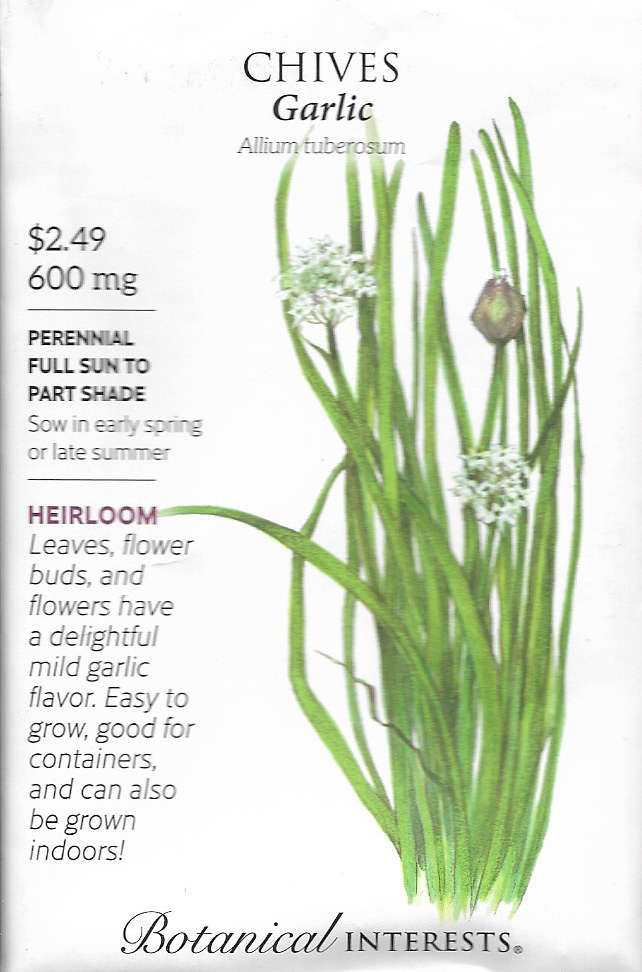 |
b) Garlic Chives Garlic chives are a versatile herb used widely in Asian cooking. When young, leaves and flower buds have a delicate aroma and a garlic flavor with hints of honey and onion. Add to stir fries, scrambled eggs, soups, and noodles, or sprinkle on meats and fish. The plant comes back every year, is good for containers and indoor growing for fresh herbs all winter long. Edible flowers are loved by bees. Family: Alliaceae Native: Asia Hardiness: Perennial in USDA zones 3–9 Exposure: Full sun to part shade Plant Dimensions: 18" tall Variety Info: Flat leaves are ¼" wide, 10"–18" long. White flowers on tubular stems bloom mid- to late summer. Garlic chives are also called Chinese chives because they are used extensively in Chinese cooking. Attributes: Drought Tolerant, Good for Containers, Attracts Pollinators, Deer Resistant |
|
|||||||||||
| Coriander / Cilantro (Start seedlings on 2/16) Cilantro/coriander is a cool-season herb that grows best in full sun and fertile, well-drained soils. Plant seeds ¼- ½ inch deep and mulch around the seedlings as soon as they emerge. Water sparingly as cilantro/coriander does not do well in damp or humid conditions. Harvest cilantro leaves when they are about 6 inches long. For coriander seeds, wait until the plant has flowered and the seed heads turn brown. Place the plant in a bag and let them dry until the seeds fall off. Side-dress 1-2 times during the growing season by applying ¼ cup of a nitrogen based fertilizer (ammonium sulfate, 21-0-0) per 25 square foot of growing area. Be careful of over fertilization, too much nitrogen can make the plant less flavorful. Coriander needs 7-14 days to germinate. Plant 1/4-1/2 inch deep. Direct sow from spring until fall. Ideal germination temperature is 65-70 F. Plants will bolt in the intense heat of summer. Space plants 1-2 inches apart. Succession sow every 2-3 weeks to keep a steady supply through the season. Space plants 2-4 inches apart for seed production.
 |
|||||||||||||
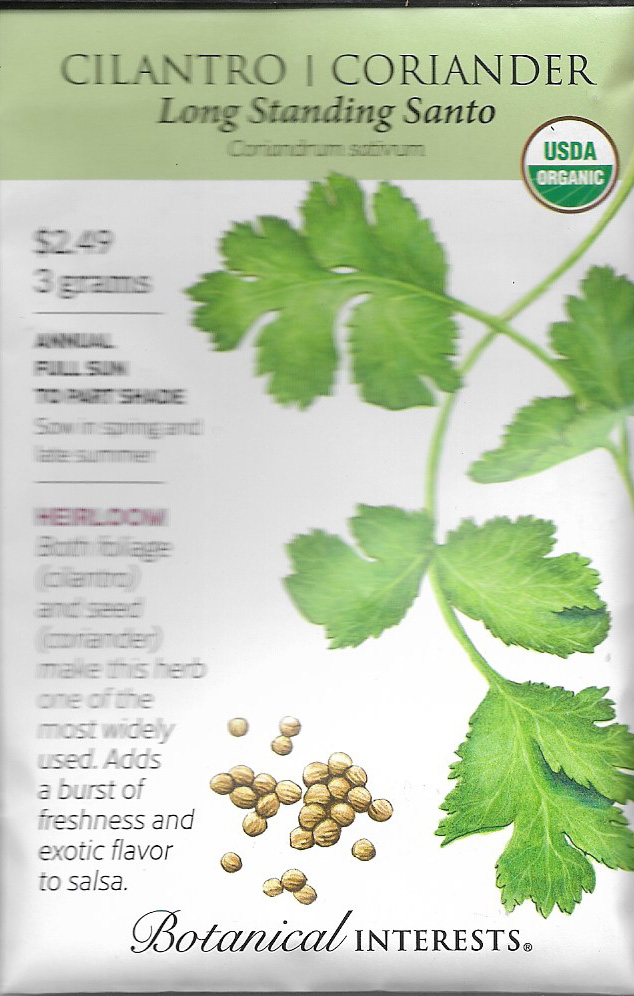 |
a) Cilantro / Coriander Also called Chinese parsley, cilantro has a thousand uses in the kitchen. 'Long Standing Santo' in particular has excellent flavor, improved leafiness and, as the name infers, it is slow to bolt. Add a sprig to chicken soup or add chopped leaves to Mexican, Caribbean, or Asian dishes. The crushed seeds add intriguing flavor to stews, beans, and cookies. Can be grown indoors for fresh cilantro leaves year-round. Cilantro grows best in cool temperatures. Family: Apiaceae Native: Mediterranean region Hardiness: Annual Exposure: Full sun to part shade Plant Dimensions: 12"–24" tall, 6"–12" wide Variety Info: Long Standing Santo' has excellent flavor, improved leafiness and when hot weather arrives, is slower to bolt (prematurely go to seed) than other varieties. Attributes: Good for Containers, Attracts Beneficial Insects |
||||||||||||
| Dill (Direct sow on February 18) Dill (Anethum graveolens) is a common, aromatic garden herb, known for its culinary and medicinal properties. Dill prefers full sun, welldrained, low fertility soils and grows best from seed. Cover seeds lightly with soil. After emergence, thin to stand and be careful not to overwater. Prune plants to promote a lush, bushy growth. Plant continuously, since it takes approximately 6 weeks to harvest. Dill flavor is best when it starts to flower. The stems, leaves, flowers, and seeds are edible so enjoy this easy to grow staple of the herb garden. Dill is not a big water user requiring one or two irrigations per week once established. Dill can tolerate drier soil conditions particularly after seed set. No additional nutrients are needed if soil is amended at planting. Seeds germinate in 7-21 days. Plant 1/4 inch deep. Direct seed in the garden as dill dislikes transplanting. Ideal germination is 67 F. Prefers full sun. Provide rich, well-drained soil. Space plants 4 inches apart. Provide good air circulation and keep foliage dry to prevent mold and fungal issues. |
|||||||||||||
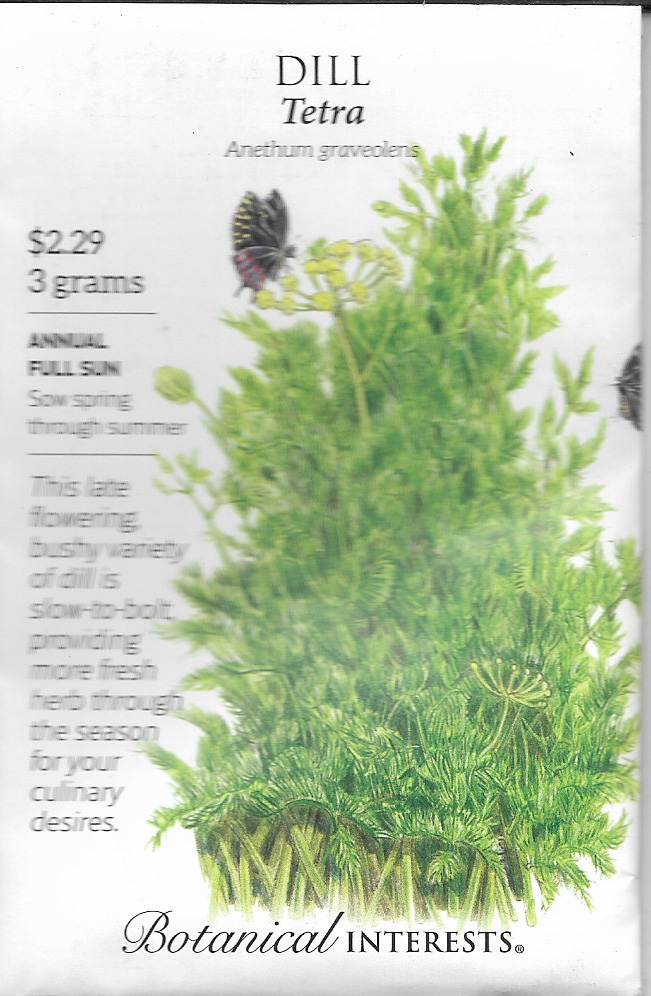 |
a) Tetra Dill The refreshing flavor of dill will surely win you over (if you don't already love it)! 'Tetra' is a bushy, late flowering variety, meaning more leaf production for dill lovers. It is heat tolerant which makes it slow-to-bolt, so you will enjoy fresh picked, aromatic dill throughout the season. Dill is an important host plant for caterpillars of swallowtail butterflies. Family: Apiaceae Native: Probably South Asia Hardiness: Frost-tolerant annual Exposure: Full sun. Plant Dimensions: 30"–36" tall, bushy plant Variety Info: Tetra' has fern-like, softly delicate, dark green, aromatic leaves. It is a late-flowering variety, lending itself to more leaf production; it is used mainly for the leaves, not the seeds. Slow-to-bolt. Attributes: Attracts Pollinators |
||||||||||||
| Oregano (Start seedlings on February 11) Seeds germinate in 4-14 days. Surface sow and gently press into soil, as light aids germination. Ideal germination temperature is 65-70 F. Space plants 12 inches apart. This creeping herb makes a lovely mat of foliage. Harvest by cutting back stems when plants are at least 6 inches tall. The best flavor is achieved when you harvest just before flowering. Don't be shy to make a hard cutback when harvesting; many will cut oregano back to the lowest few leaves in early summer and again in late summer. A half-strength dose of NPK fertilizer, applied judiciously before planting and post-pruning, usually does the trick. Nitrogen boosts leafy growth, phosphorus strengthens the roots, and potassium enhances overall health. You can air dry or use a dehydrator, easily growing your year's supply of dried oregano. Oregano is generally pest and disease free, but you may see aphids or spider mites on the plants. If the infestation becomes out of control (not common) blast the plants with a strong stream of water from the hose to knock the insects from the plants.
|
|||||||||||||
| Parsley (Started seedlings on February 11) Use a liquid fertilizer at one-half the label recommended strength every three to four weeks.  |
|||||||||||||
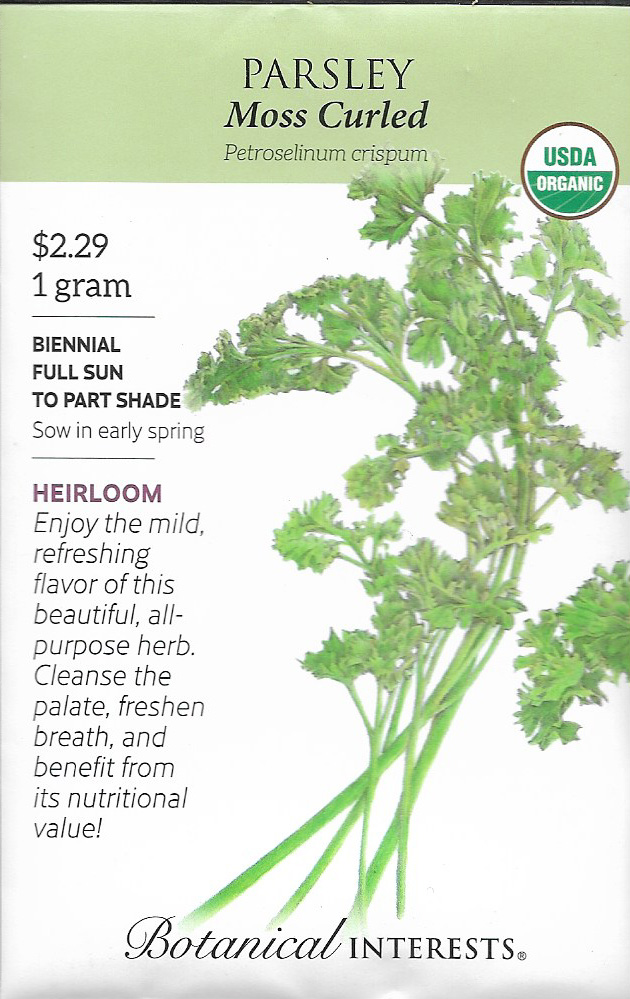 |
a) Moss Curled Parsley Grown as an annual, 'Moss Curled' parsley can grow through fall and into winter because of its cold tolerance. It has a milder flavor than flat-leaved types and can enhance almost any food, in flavor and in beauty. It is a very nutritious herb (vitamins A, B, C), and freshens breath. Pair with flowers in ornamental plantings, and grow indoors in the winter! Family: Apiaceae Native: Widely cultivated; origin unknown Hardiness: Biennial grown as an annual because the best flavor comes from first year leaves. Leaves become bitter when flowers appear in the second year. Exposure: Full sun to part shade Plant Dimensions: 10"–12" tall and wide Variety Info: Mounding plants with dark green, deeply cut, curled leaves with a milder flavor than flat-leaf types. |
||||||||||||
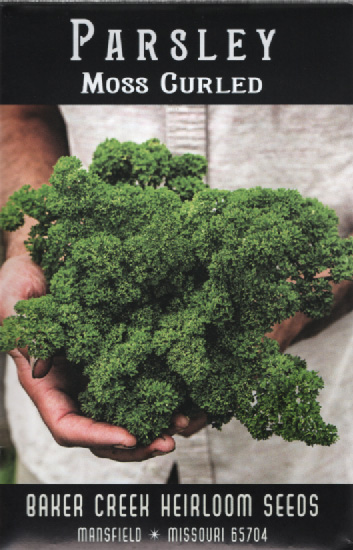 |
b) Moss Curled | ||||||||||||
| Sage (Start seedlings on February 16) Seeds germinate in 7-14 days. Press seeds gently into soil but do not cover, as light aids germination. Ideal germination temperature is 65-75 F. Prefers full sun to part shade. Plants do not like excessive moisture. Space plants 12-18 inches apart. If slugs are an issue, sprinkle diatomaceous earth around the base of the plant. |
Rare Seeds |
||||||||||||
| Tarragon (Started 5 seedlings on February 11) Fertilizer is not required for tarragon to thrive. Planting it in low-nutrient soil yields the best flavor. Only during the initial planting phase is it appropriate to use an all-purpose variety. |
|||||||||||||
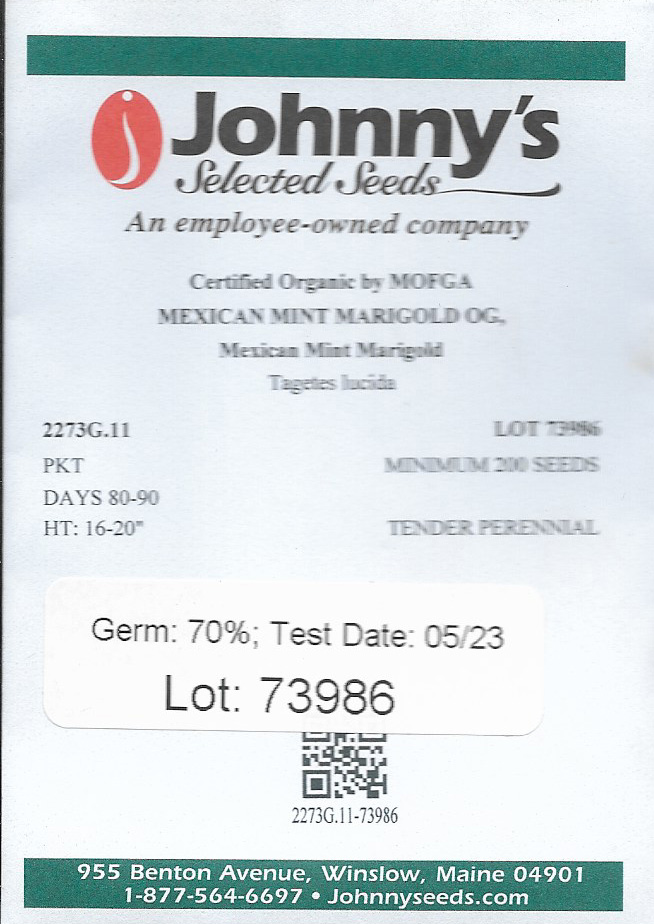 |
a) Mexican Mint Marigold
Aromatic leaves are a substitute for French tarragon. Sweet licorice flavor brightens salads and main dishes. The edible, pretty, golden-yellow flowers bloom all summer. Thrives in warmer climates where French tarragon will not grow. Also known as sweet mace or Mexican tarragon. Edible Flowers: Use the flowers to garnish desserts and drinks with the same sweet licorice flavor as the leaves. USDA Certified Organic. |
||||||||||||
| Thyme (Start seedlings on February 16) Thyme seeds are best started indoors. Surface sow and lightly cover seeds with fine soil, and water thoroughly but gently. Place seeds in a warm area and cover to hold in moisture. Ideal germination temperature is 60-75 F. Seeds germinate in 14-21 days. Space plants 6-8 inches apart. Transplant to full sun area once seedlings are established. A side-dressing of compost or worm castings in spring can suffice, especially for in-ground plants. For containerized thyme, consider a balanced, slow-release granule or a diluted liquid fertilizer once or twice a year
|
|||||||||||||
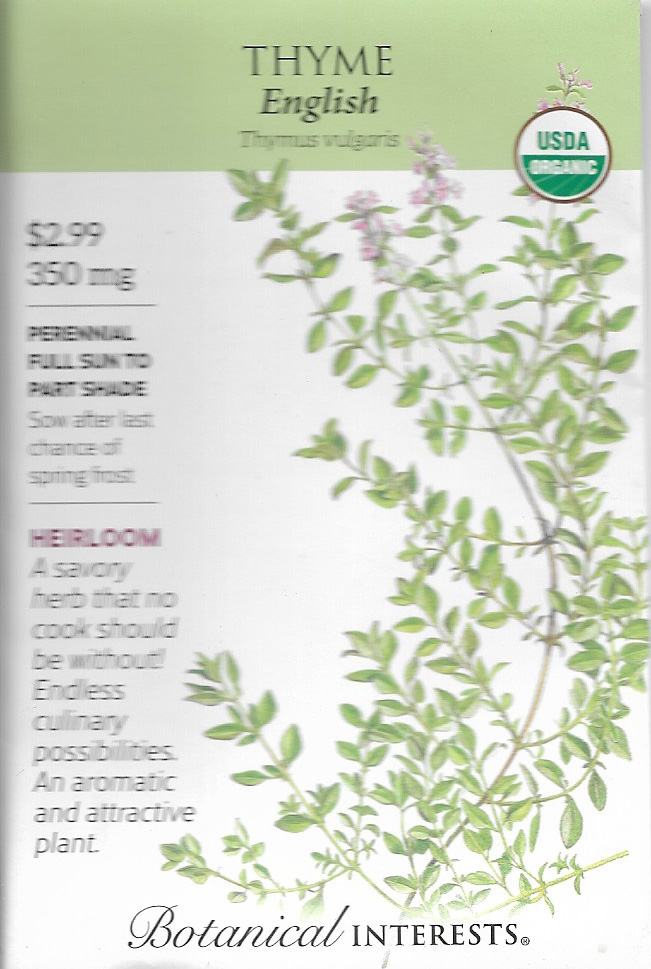 |
a) English Thyme An invaluable seasoning in the kitchen, thyme has a subtle, woodsy flavor that complements a variety of foods. A staple herb of chefs, and one of the primary ingredients of bouquet garni. With very small leaves and delicate, edible flowers, thyme makes a lovely, drought-tolerant, 12"-tall landscape plant; use as a low hedge around your herb or vegetable garden. An excellent container plant to enjoy indoors or out. Family: Lamiaceae Native: Africa and Western Europe Hardiness: Perennial in USDA zone 5–9 Exposure: Full sun to part shade Plant Dimensions: 6"–12" tall and wide Variety Info: Very small (¼"), very fragrant leaves with white to light pinkish/purple flowers in early summer. Evergreen herb used in cooking and for ornamental purposes. Essential in Herbes de Provence. Attributes: Attracts Pollinators, Drought Tolerant |
||||||||||||

